Key takeaways
- Activist teacher resources foster critical thinking and empathy, transforming education into a meaningful experience.
- Incorporating local authors enhances student engagement by providing relatable narratives that reflect their communities.
- Collaborations with local authors empower students and validate their experiences, fostering a sense of identity and agency.
- Challenges in partnering with local authors can be overcome through flexibility, clear communication, and creative solutions.

Understanding activist teacher resources
Activist teacher resources are more than just lesson plans or materials; they are tools imbued with purpose and passion. I’ve found that these resources often come from educators who have experienced injustice firsthand, making their contributions incredibly relatable and powerful. Have you ever noticed how such resources invite you to question the status quo rather than accept it passively?
When I first explored activist teacher resources, it struck me how they encourage critical thinking and foster empathy in students. These materials go beyond traditional teaching; they create spaces where students feel seen and heard. Isn’t that the kind of engagement every classroom deserves?
What makes these resources truly valuable is their alignment with real-world struggles and realities. For me, the emotional connection they build transforms education from abstract to meaningful. It’s about cultivating activists, not just learners, and that shift changes everything.
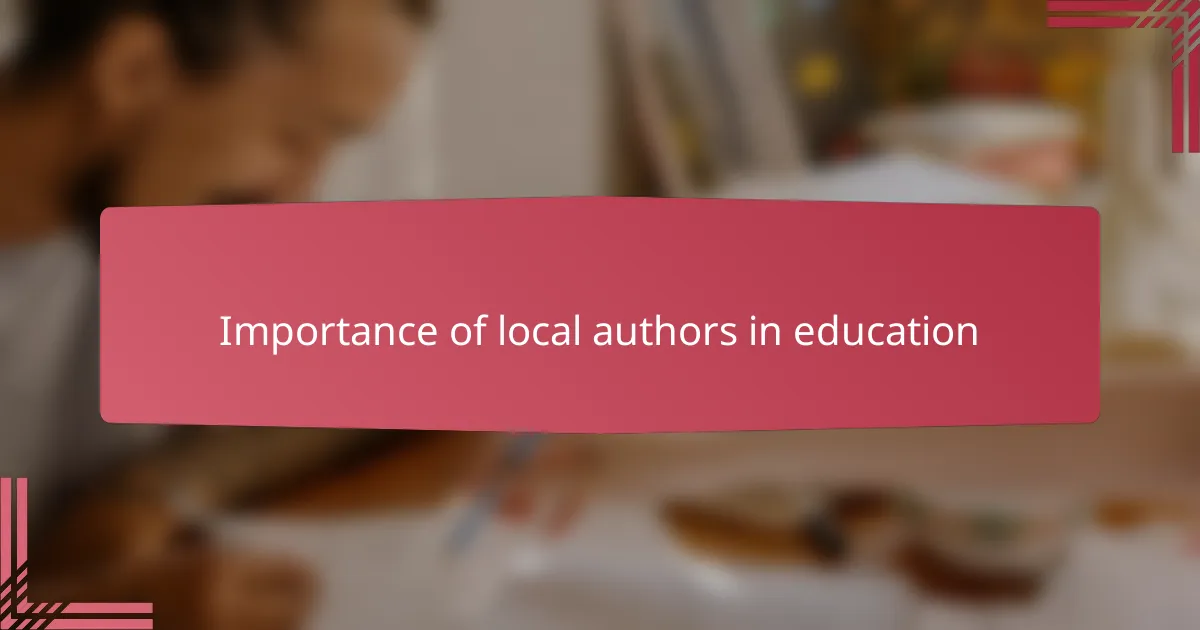
Importance of local authors in education
Whenever I include works by local authors in my teaching, I notice a shift in how students connect with the material. There’s something undeniable about seeing stories and voices that reflect their own communities—it makes learning feel less distant and more personal. Have you ever seen a student’s eyes light up because they finally recognize their own experiences in a book? That moment of recognition is powerful.
Local authors bring authenticity that national or international voices sometimes can’t match. Their stories carry the textures of local struggles, triumphs, and culture, making lessons resonate on a deeper level. From my experience, this authenticity sparks discussions that are richer and more grounded in real life, which is exactly what we need in activist education.
It’s not just about relatability, though. Including local authors also honors and uplifts diverse voices that might otherwise be overlooked. I’ve found that this practice cultivates pride in students and encourages them to see themselves as valid storytellers and agents of change. Isn’t education supposed to empower, after all?
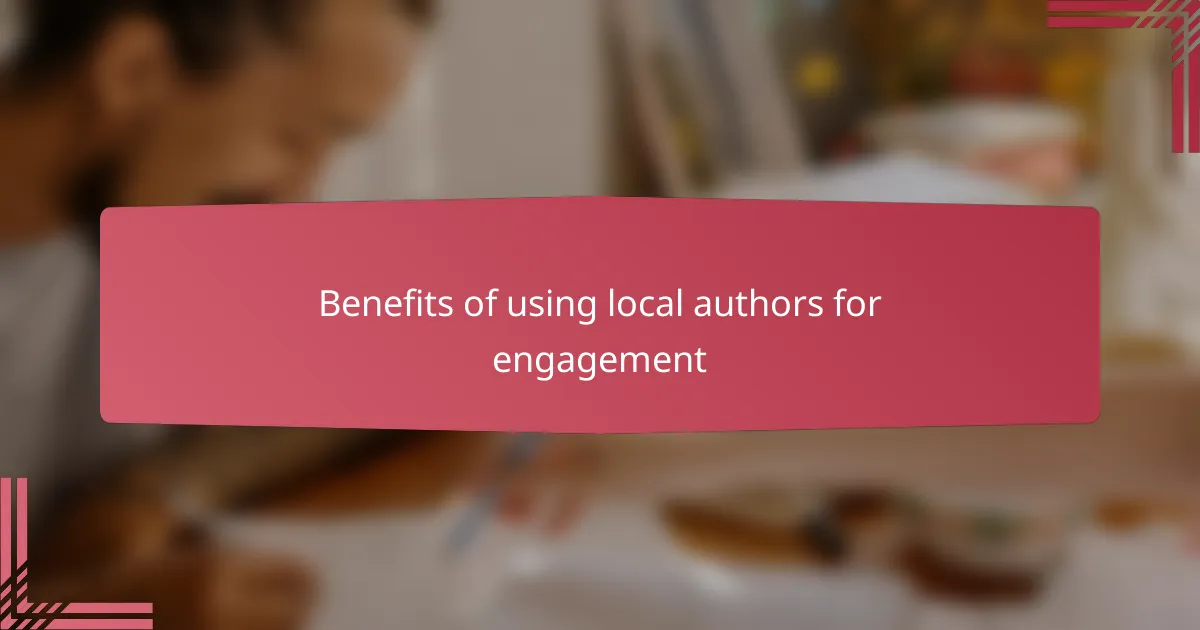
Benefits of using local authors for engagement
There’s something uniquely engaging about bringing local authors into the classroom. I remember a day when a student shared how a poem by a local writer mirrored her own family’s struggles. That moment sparked a flood of conversations that went beyond the lesson—conversations rooted in shared reality and genuine emotion. Isn’t that the kind of engagement we strive for?
Using local authors also builds a bridge between students and their communities. I’ve seen firsthand how this connection breeds curiosity and pride. When students recognize their neighborhoods, histories, or dialects in text, they start asking questions that go deeper, connecting literature to life in ways no textbook can inspire.
Finally, I think local authors provide a crucial platform for voices often ignored in mainstream discourse. By highlighting these perspectives, we not only diversify what’s taught but also validate the experiences of students who may have felt invisible before. Have you noticed how validation can transform confidence? For me, that transformation is at the heart of meaningful engagement.
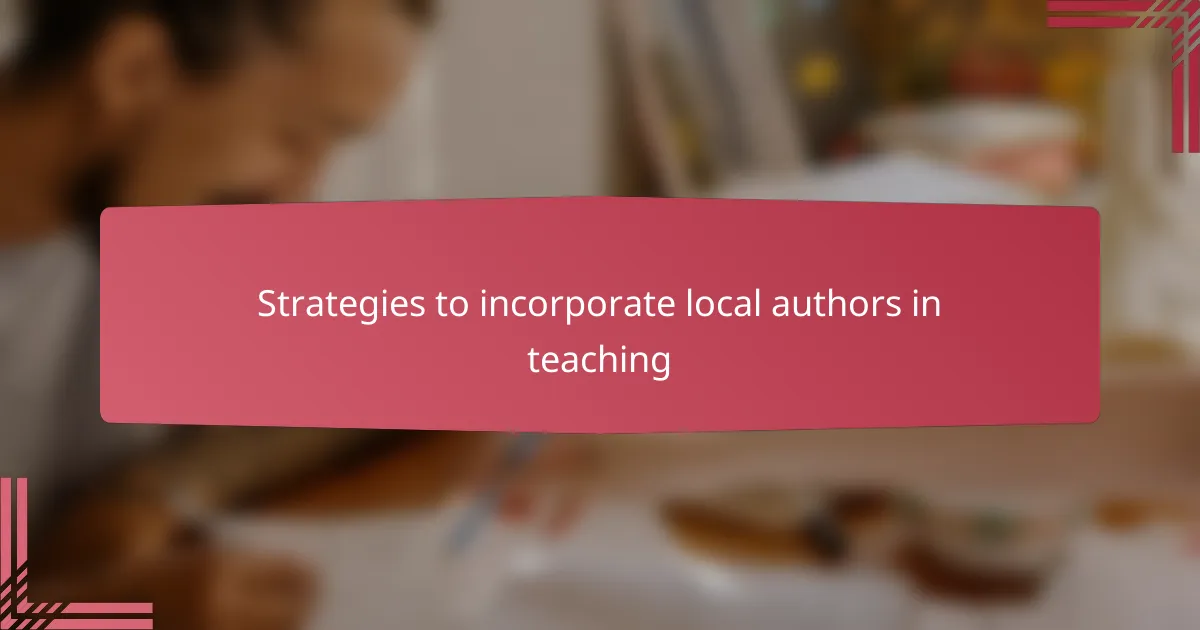
Strategies to incorporate local authors in teaching
One approach I’ve found effective is inviting local authors to share their stories directly with students, whether through classroom visits, virtual talks, or recorded interviews. When students hear these voices firsthand, it creates an immediacy and authenticity that can’t be replicated by any textbook. Have you ever noticed how hearing someone’s lived experience can spark questions and reflections that surprise even you?
Another strategy is to integrate local authors’ works across subjects, not just in language arts. For example, history lessons can come alive when paired with local narratives that reveal community struggles or activism. I recall a unit where students connected historical events with poems from a neighborhood activist poet—it turned abstract facts into something intensely personal and real. Doesn’t linking multiple perspectives make learning stick better?
Lastly, collaborating with local authors on projects empowers students to become creators themselves. I once guided a class in writing reflections inspired by a local author’s style, and the pride in their voices was palpable. This process didn’t just teach writing; it cultivated agency and belonging. Could there be a richer way to foster student engagement than by validating their own stories alongside those of local authors?
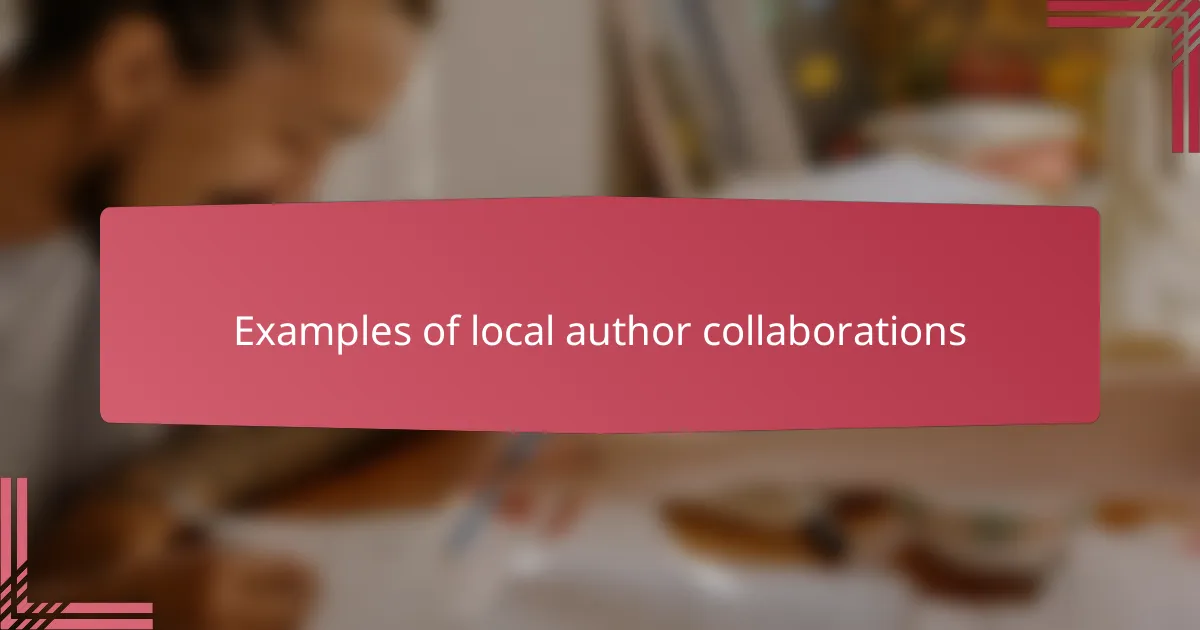
Examples of local author collaborations
One memorable collaboration involved partnering with a local poet whose work centered on social justice themes relevant to our community. When this author visited the classroom, I witnessed students’ faces light up as they connected deeply with the poetry, sparking heartfelt discussions about their own experiences. Have you ever seen students suddenly find their voice because someone from their neighborhood shared theirs first?
In another instance, a local novelist worked alongside my class to co-create stories reflecting our town’s history of activism. This hands-on collaboration didn’t just make history tangible—it empowered students to see themselves as part of that ongoing narrative. I can’t forget how one shy student proudly read aloud a story inspired by her family, a moment that truly changed how she engaged with learning.
Sometimes, a simple partnership with a community children’s author can have a big impact. I once used illustrated picture books by a nearby author to introduce topics of diversity and inclusion. Watching students relate to characters who looked and spoke like them was a powerful reminder of why local authors matter. Don’t those small moments of recognition and belonging make all the difference in engagement?
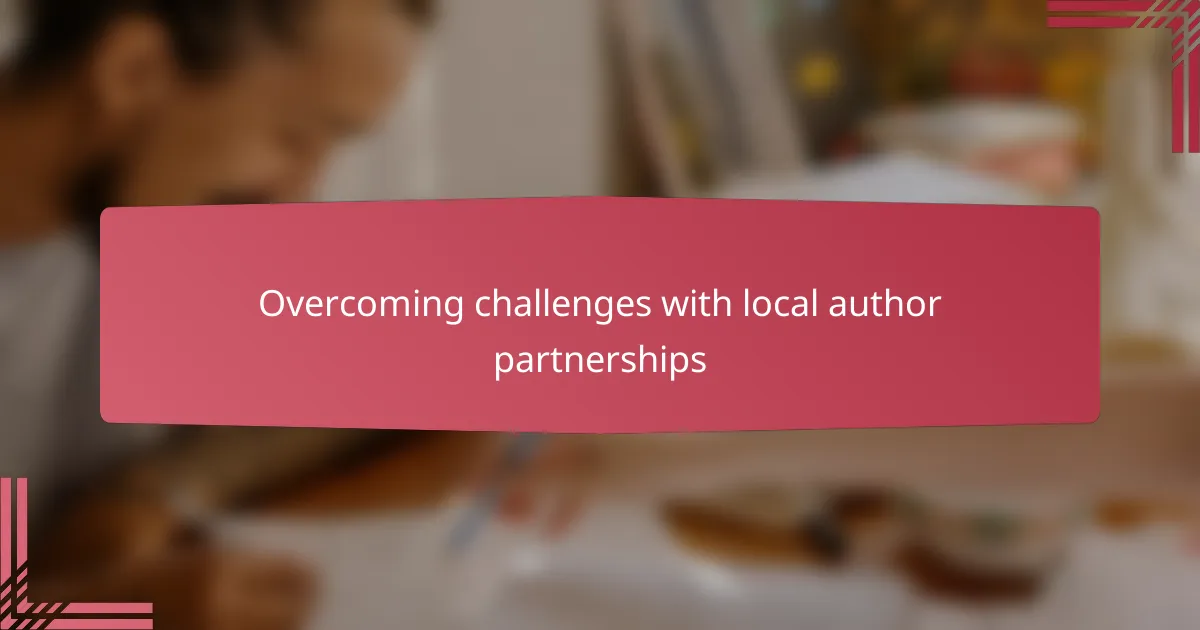
Overcoming challenges with local author partnerships
Partnering with local authors isn’t always smooth sailing. I’ve encountered scheduling conflicts and limited availability, which at first felt frustrating. But over time, I learned that flexibility and clear communication create the space needed to overcome these hurdles—have you ever noticed how patience often opens doors you thought were closed?
Another challenge is ensuring that collaborations align with curriculum goals without losing the author’s authentic voice. This balancing act took some trial and error for me, but involving authors early in the lesson planning helped build mutual understanding. Isn’t it rewarding when those conversations lead to materials that resonate deeply with students?
Lastly, I’ve wrestled with limited resources—both time and funding—to support these partnerships. Creative solutions like virtual visits or community sponsorships came to the rescue, proving that obstacles can spark innovation. Have you tried thinking outside the box to keep meaningful author connections alive despite constraints?
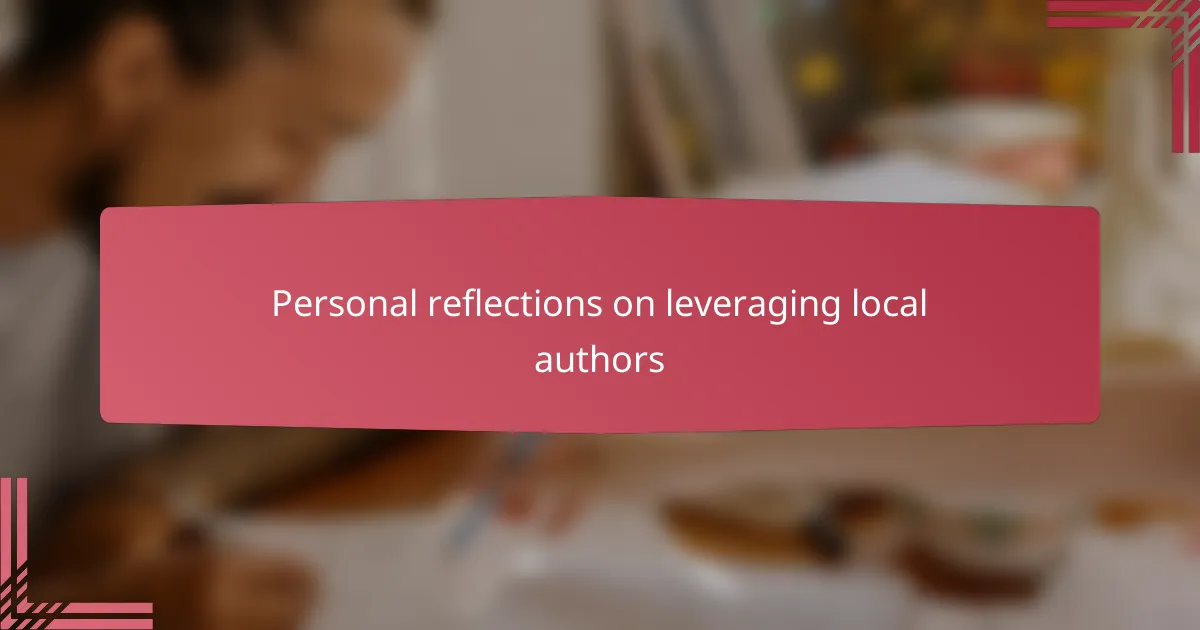
Personal reflections on leveraging local authors
I’ve noticed that leveraging local authors transforms the classroom environment in subtle yet powerful ways. When students encounter voices from their own communities, it’s as if a door opens—suddenly, abstract ideas become tangible and deeply relevant. Have you ever witnessed that quiet moment when a student realizes, “This is my story too”? Those moments have stuck with me as some of the most profoundly engaging.
At times, I’ve felt a mix of excitement and vulnerability introducing local authors’ works, wondering how students will respond. But more often than not, what unfolds is a genuine connection that surprises and inspires me. It feels like those authors bring a piece of the neighborhood’s heartbeat into the room, making lessons resonate beyond textbooks. Isn’t that the kind of engagement every educator hopes to spark?
On reflection, I see local authors as bridges—not just to cultural authenticity but to student identity and agency. When their voices enter the curriculum, I’ve found the classroom becomes less a space of imposed learning and more a community of shared stories. This shift has, in my experience, helped students find confidence in their own narratives and motivated them to engage with activism in a way that feels personal and urgent. Have you felt that transformative energy in your teaching practice?